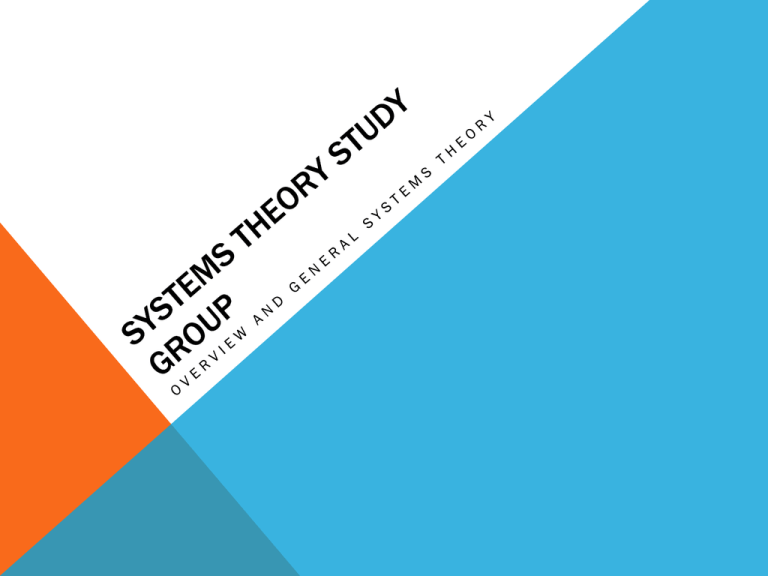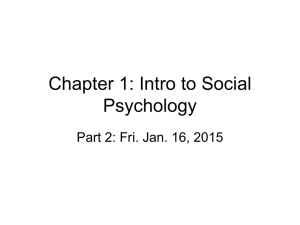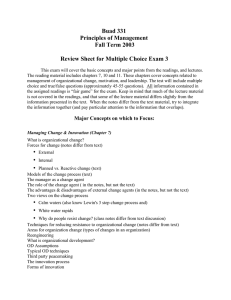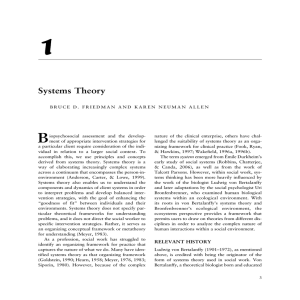Systems Theory study group
advertisement

SYSTEMS THEORY STUDY GROUP What are theories? • Ways of conceptualizing behaviors, relationships, and problems • Represents your worldview – your way of making sense out of things • Ideas and concepts which form the basis for the various models which we study and use • Philosophical approach to therapy, relationships, and problems 2 SYSTEMS THEORY STUDY GROUP Why are they important? • Your “house” is built upon one or more theoretical approaches • How you choose to intervene and provide therapeutic services are guided by your particular philosophical understandings • Your choice(s) of model(s) will be informed by your theoretical underpinnings • Therapy requires a strong understanding of theories • Helps you meet the client’s needs • Is required for passing the national exam 3 SYSTEMS THEORY STUDY GROUP How many theories are there? • That’s a great question • That depends upon who you ask • There are ways to conceptualize these theories into various categories • Ingoldsby et al. (2004) highlighted 9 theories related to families 4 SYSTEMS THEORY STUDY GROUP Strategic Structured Experiential Behavioral Intergenerat ional Centers MRI, HaleyMadanes Institute, Institute for Family Studies, Ackerman Institute Philadelphia Child Institute Big Sur Univ of Oregon Georgetown Family Center People Jackson, Watzlawick, Haley, Madanes, Palazzoli Minuchin Satir and Whitaker Weiss Bowen Assumption s about problem Communication problems; problem solving problems; stuck Change over time; structural imbalances; internal/external factors Interactions shaped by other experiences; need for validation; failure to connect Learning; negative reinforcement; coercive cycles Intergenerational; emotional systems of family; emotional imbalances in family Change Disrupt cycle; get unstuck ID system level of problem; learn new patterns Challenge assumptions; confrontation and feeling Positive reinforcement; reciprocal reinforcement Safely handle feelings; use extended family Techniques Paradox; reframe; letters Joining; enactments; crisis Sculpting Goal setting; Behavior tracking Coaching; Genogram 5 SYSTEMS THEORY STUDY GROUP This is the basic format for what you might want to include in your own chart. This will help you track the various models and the significant data related to each. Theory Theory Theory Theory Theory Centers People Assumption s about problem Change Techniques 6 SYSTEMS THEORY STUDY GROUP Tonight we will discuss general systems theory because it is the foundational core of much of the rest of family systems theory 7 SYSTEMS THEORY STUDY GROUP General systems theory • Derived from the work of Bertalanffy • Viewed the world from a biological perspective • Attempted to give meaning to how biological systems operate • Teaches us that the whole is greater than the parts • Components are interdependent (change in 1 causes change in others) • AKA: Systems theory, Open systems theory, Systemic theory 8 SYSTEMS THEORY STUDY GROUP General systems theory Systems theory was proposed in the 1936 by the biologist Ludwig von Bertalanffy, and further developed by Ross Ashby. von Bertalanffy was both reacting against reductionism and attempting to revive the unity of science. He emphasized that real systems are open to, and interact with, their environments, and that they can acquire qualitatively new properties through emergence, resulting in continual evolution. Rather than reducing an entity (e.g. the human body) to the properties of its parts or elements (e.g. organs or cells), systems theory focuses on the arrangement of and relations between the parts which connect them into a whole (cf. holism). This particular organization determines a system, which is independent of the concrete substance of the elements (e.g. particles, cells, transistors, people, etc). Thus, the same concepts and principles of organization underlie the different disciplines (physics, biology, technology, sociology, etc.), providing a basis for their unification. Systems concepts include: system-environment boundary, input, output, process, state, hierarchy, goaldirectedness, and information. An information system is an example of the interaction of multiple elements as envisioned by GST. Source: http://pespmc1.vub.ac.be/SYSTHEOR.html 9 SYSTEMS THEORY STUDY GROUP General systems theory All systems have common elements. These are: input output throughput or process feedback control environment goal 10 SYSTEMS THEORY STUDY GROUP Term Definition Examples Input The material/information transformed by the system Information; digital input; analog input Throughput The process used to make sense of input Thinking, planning, decision making Output The results of the input and throughput Family decisions Feedback Information received regarding output Negative feedback; positive feedback Subsystem A 2nd system within a system Parental system Closed system Fixed relationships – not open to outside influence Enmeshed families 11 SYSTEMS THEORY STUDY GROUP Term Definition Examples Open system Interacts with surroundings and outside influences Family with healthy boundaries Boundary Differentiates one system from another Hierarchy; parents/children Negentropy Tendency toward homeostasis Develop rules to return to normalcy Entropy Tendency toward chaos Dysfunctional families; addicted families Equifinality End result can be reached by various means Decision on resolving conflict in marriage Cybernetics The ways in which systems operate Closed/open/feedback loops 12 SYSTEMS THEORY STUDY GROUP Term Definition Examples Homestasis Normal state of a system Family faces conflict and returns to a balanced system Negative Feedback Homeostatic maintainer- Behavior that restores system to a comfort range Child individuates and is punished – remains enmeshed Positive Feedback Pro-change behavior that upsets equilibrium beyond thresholds of accustomed behaviors Teenager challenges authority and results in rules changes 1st Order Change Change that occurs within a system that itself remains unchanged Change within an individual 2nd Order Change Change that alters the system itself Addicted family enters into recovery 13 SYSTEMS THEORY STUDY GROUP 14 SYSTEMS THEORY STUDY GROUP 15 SYSTEMS THEORY STUDY GROUP 16 SYSTEMS THEORY STUDY GROUP 17 SYSTEMS THEORY STUDY GROUP 18 SYSTEMS THEORY STUDY GROUP 19 SYSTEMS THEORY STUDY GROUP Resources http://quizlet.com/2873390/new 20







